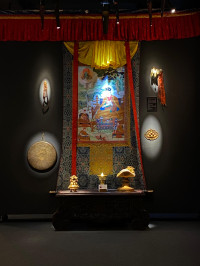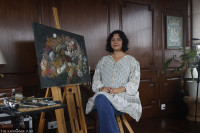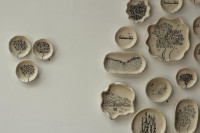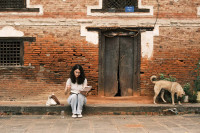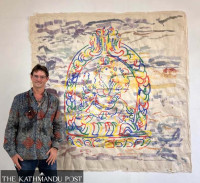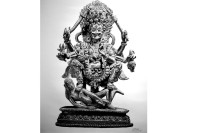Arts
A larger picture of portraiture art
Danfe Arts and Taragaon Museum’s ‘A Portrait Story’ attempts to stray away from the orthodox idea of portraits in art.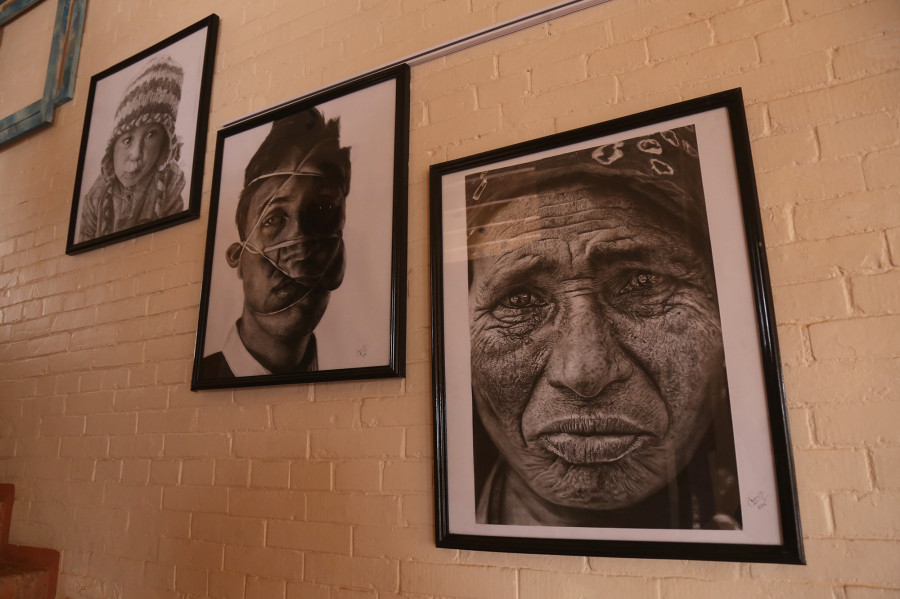
Ankit Khadgi
In the baby pink background, there is an illustration of a finger inside a mouth. Next to this, in a blue background, there is another illustration of someone digging their nose. These artworks may not have the conventional definition of what a portrait painting should be, but it efficiently conveys the qualities of portraiture—mood, personality, and understanding of the subject.
Straying away from the orthodox definition of a portrait art has been the theme of the new exhibition titled ‘A Portrait Story’. Organised by Danfe Arts and Taragaon Museum, the exhibition brings together the work of more than 40 Nepali artists—from veterans like Shashi Bikram Shah, Dirgha Man Chitrakar to upcoming artists like Rashana Bajracharya, and Manish Dhoju. Curators Shivangi Bansal from Danfe Arts and Roshan Mishra from Taragaon Museum believe this exhibition will highlight the brilliant portrait works of the Nepali artists.
“We wanted to bring portrait artworks to the forefront as they are the kind of work that isn’t as recognised,” says Bansal, founder of Danfe Arts.
There are 75 artworks in the exhibition that includes paintings, photos, installation art, sketches, digital manipulation, among others. The viewers can enjoy the varieties of the artwork, as per their preference.
Artist Manish Dhoju’s hyper-realistic art is one of the highlights of the exhibition. In his work titled ‘Tension,’ the artist showcases stories of three different life cycles. The innocence of childhood, confinement because of the societal expectations during adulthood, and loneliness in the advancing years are the main themes of his portraits. Using charcoal and pencil on paper, Dhoju’s artwork is simple yet powerful. The detailing in the portraits is exceptional, and for a novice artist, he certainly has been successful in making a mark.
In his artworks, onlookers can even see a reflection of themselves—almost like pulling in the audience inside his art. It is not just to look at, but to experience.
But not all the artworks in the exhibition are personal. Bidhata KC’s ‘Means to End’ highlights the struggles of sex workers. Through her paintings, KC portrays what the sex workers have to go through in their daily lives and how their choices define them in the constraints of social structure—hence, detailing their means to end. In one of her paintings, a woman’s portrait is surrounded by different digits, a remarkable expression of how the identities and worth of these women are limited to the cost of their services.
As exemplified by KC’s paintings, art is a powerful medium to highlight social issues. In the exhibition, there were many instances of artists taking heed of the current social context in their artworks.
Sazeed Shakya’s ‘The Yellow, the blue and the Red’ represents the omnipresence of mobile phones in people’s lives. A striking thing that is visible in all of his three paintings is that the subjects are headless. This could be a subtle way to represent the artist’s interpretation of how technology has led to the death of the people’s mindfulness.
Similarly, mixed media artist Hit Man Gurung’s ‘The Revolutionary Dreams,’ showcases the issue of migrant labour, and how that has been fast manifesting in Nepali culture. Through the medium of performance photography, he tells stories of migrant labourers in four frames. The photos feature the same person, where on one side, he is shown as a farmer, a student, a teacher and army personnel. Then, in the same pictures, standing next to these character representatives, stand a person wearing a helmet and a safe jacket.
The main underscore of the exhibition is the diversity of the artists as well as the art. The curators have clearly attempted to redefine portraiture in Nepal, and they have been considerably successful.
Even in those artworks that are presented very close to the conventional form of portraiture paintings, there is a variety to it. A portrait of Sapna Pradhan Malla, justice of the Supreme Court of Nepal, by Rashana Bajracharya hinges on the expression of the subject. But in paintings by Siddhant Rai, the subject’s face or even their facial expressions aren’t well-defined. His artworks are like a voyeuristic glimpse of his subjects’ unusual movements.
With such variety and number, the exhibition is undoubtedly rich, and a platform for all art lovers to explore the variegation in Nepali art. The decision of having too many artworks, however, can come with its own baggage, as all of the visitors may not have time to deeply understand each and every artwork.
Having said that, all of the 75 artworks have detailed work and are unique in their own way. Apart from breaking the norm on portraiture artwork, the exhibition also works as a platform to introduce young talented artists.
This exhibition will be held until January 23 in Taragaon Museum, Boudha. A panel discussion on art from a curatorial perspective will be held on January 16, in Malla Hotel, Lainchour, as a part of the exhibition.




 14.12°C Kathmandu
14.12°C Kathmandu
